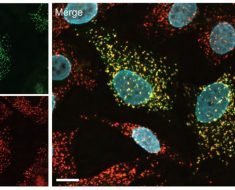The cerebral cortex—the brain’s epicenter of high-level cognitive functions, such as memory formation, attention, thought, language and consciousness—has fascinated neuroscientists for centuries.
Scientists have long known that this “command center” is organized into six distinct regions, or layers, but how this complex organization arises during development has remained largely a mystery.
Now, research led by Harvard Medical School scientists provides some tantalizing new clues into the development of the mammalian cerebral cortex.
The experiments, published June 6 in Neuron, were conducted in mice. If replicated in further studies, these findings could reshape our understanding of a range of neurodevelopmental disorders.
The results reveal that one big key to the mammalian cortex’s complex organization is a gene expressed in neural stem cells during early development—but not the neurons themselves. When the function of this gene goes awry early in development, so does the cortex’s organization later on.
To better understand cerebral cortex organization, study leaders Corey Harwell, assistant professor of neurobiology at Harvard Medical School, and José Manuel Baizabal, a research fellow in neurobiology in Harwell’s lab, focused on a protein called PRDM16. Previous research had shown that this protein helps maintain the integrity of neural stem cells—the cells that produce neurons—and help their progeny become neurons throughout development.
In a set of initial experiments, researchers analyzed the activity of the gene that makes PRDM16 in the cerebral cortices of several mammalian species, including humans. They observed that the gene is active across all species—a conservation that underscores the gene’s importance during neural development across multiple organisms, the researchers said. Importantly, this gene is only active in neural stem cells but is not active in the neurons that they subsequently make.
To elucidate the gene’s role in the brain, the researchers created animal models in which the gene’s activity was turned off. As the brains of these animals developed, their cortices grew to the same size as those in animals with normally active PRDM16. However, the organization of the cortices in animals with inactive PRDM16 was significantly altered: the neurons normally located in outer layers did not find their path and remained “stuck” in deeper layers.
“This finding suggests that the migration of neural cells from where they’re ‘born’ in the brain to where they ultimately end up is impaired when PRDM16 isn’t working,” Harwell said. “We observed that neurons of animals whose brains lacked PRDM16 couldn’t find the right positions, resulting in inappropriate cortical architecture.”
But why and how exactly did removing PRDM16 cause such misarranged structure and improper neuronal maturation, the scientists wondered. Previous research had already shown that this protein latches onto many sites across the entire genome of cells, affecting the expression of many genes by chemically modifying the structure of their DNA without changing the DNA sequence itself. When the researchers compared gene activity in the neural progenitor cells of animals with PRDM16-deficient brains and those with normal levels of the protein, they found that removing PRDM16 affected more than 1,000 other genes and altered their ability to produce their respective proteins.
An even closer look, added Harwell, showed that PRDM16 attaches to more than 30,000 sites of the genome that are considered noncoding—meaning that they don’t directly produce proteins. But these sites are critical because they coordinate the activity of genes that are involved in establishing the number and position of neurons. That regulation appears to be passed down from progenitor to progeny, Harwell explained, affecting cells downstream of those in which PRDM16 activity is absent. In other words, only cortical neurons that have the right stem-cell lineage or pedigree are able to reach their final position in the cerebral cortex.
One of these genes directly regulated by PRDM16 known as Pdzrn3, appears to be a key regulator of the ultimate organization of the brain. The researchers showed that removing PRDM16 boosted expression of Pdzrn3 in newly produced neurons, which reduced the ability of these cells to migrate to the brain’s outer layers. When the researchers reduced Pdzrn3 to normal levels, migration reverted to normal too.
Source: Read Full Article





